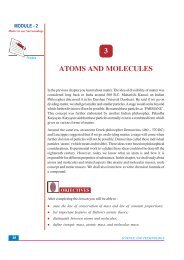8. Acids, Bases and Salts (41.1 MB)
8. Acids, Bases and Salts (41.1 MB)
8. Acids, Bases and Salts (41.1 MB)
You also want an ePaper? Increase the reach of your titles
YUMPU automatically turns print PDFs into web optimized ePapers that Google loves.
MODULE - 2<br />
Matter in our Surroundings<br />
Notes<br />
<strong>Acids</strong>, <strong>Bases</strong> <strong>and</strong> <strong>Salts</strong><br />
2. Process: It is manufactured by Hasen-Clever Method. The plant consists of four<br />
cylinders made of cast iron with inlet for chlorine near the base. The dry slaked<br />
lime, calcium hydroxide is fed into the chlorinating cylinders from the top. It moves<br />
down slowly <strong>and</strong> meets the upcoming current of chlorine. As a result of the<br />
reaction between them, it is converted into bleaching power which collects at<br />
the bottom.<br />
Ca(OH) 2 + Cl 2 ⎯→ CaOCl 2 + H 2 O<br />
slaked lime chlorine bleaching<br />
powder<br />
(b) Uses<br />
1. In textile industry for bleaching of cotton <strong>and</strong> linen.<br />
2. In paper industry for bleaching of wood pulp.<br />
3. In making wool unshrinkable.<br />
4. Used as disinfactant <strong>and</strong> germicide for sterilization of water.<br />
5. For the manufacture of chloroform.<br />
6. Used as an oxidizing agent in chemical industry.<br />
INTEX QUESTIONS <strong>8.</strong>5<br />
1. Identify acid radical <strong>and</strong> basic radical in CaSO 4 .<br />
2. CuSO 4 was prepared by reacting an acid <strong>and</strong> a base. Identify the acid <strong>and</strong> the<br />
base that must have been used in this reaction.<br />
3. Which one of the following is the correct formula of plaster of paris?<br />
CaSO 4 .H 2 O or 2CaSO 4 .H 2 O<br />
WHAT YOU HAVE LEARNT<br />
<br />
<br />
<br />
<strong>Acids</strong> are the substances which taste sour, change blue litmus red, are corrosive<br />
to metals <strong>and</strong> furnish H + ions in their aqueous solutions.<br />
<strong>Bases</strong> are the substances which taste bitter, change red litmus blue, feel slippery<br />
<strong>and</strong> furnish OH – ions in their aqueous solutions.<br />
Indicators are the substances that show one colour in an acidic medium <strong>and</strong><br />
another colour in a basic medium. Litmus, phenolphthalein <strong>and</strong> methyl orange<br />
are commonly used indicators.<br />
182<br />
SCIENCE AND TECHNOLOGY
















